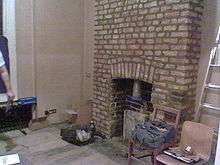Chimney breast
A chimney breast is a portion of a chimney which projects forward from a wall to accommodate a fireplace.[1] Typically on the ground floor of a structure, the masonry extends upwards, containing a flue which carries smoke out of the building through a chimney stack.[2] Chimney jambs similarly project from the wall, but they do so on either side of the fireplace and serve to support the chimney breast.[3] The interior of a chimney breast is commonly filled with brickwork or concrete.[4]

The construction and appearance of a chimney breast can vary according to function and style. English and American builders more often treat the chimney breast and fireplace as distinct architectural features, whereas French buildings have gradually trended towards concealed construction.[5]
False chimney breasts
False chimney breasts are sometimes constructed around a twin-walled flue, or against a wall pierced by a flue, for purely cosmetic purposes. Typically they will consist of a timber frame or stud work covered with plaster board and a plaster skim. If the false breast contains a flue it may be necessary to line it with a refractory material such as vermiculite. Usually, additional cosmetic features will be added such as cosmetic beams, overmantels or fireplace surrounds.
Removal
Chimney breasts often become redundant with respect to their function as a chimney, due to installation of alternative heating methods such as central heating. Removal of the chimney breast can provide more floor space and a more regular shaped room. However, chimney breasts often have structural function. Therefore removal needs to be done with care, and preferably with professional advice. The removal of part (especially the lower part) of a breast can cause uneven loading on a wall, especially if the upper part is not suitably supported, ideally on an I-beam.[6] In some cases support on a steel beam and post, or by gallows brackets may be acceptable.
Other factors that need to be considered when removing a chimney breast are:[7]
- Fire safety, in particular for party walls.
- Noise insulation
- Effect on neighbour's chimney
- Damp prevention
- Ventilation
References
- Jack Stroud Foster; Roger Greeno (2007). Structure and Fabric. Prentice Hall. p. 190. ISBN 0-13-197094-1.
- Burkinshaw, Ralph; Parrett, Mike (2003). Diagnosing Damp. RICS Books. p. 55. ISBN 9781842190975.
- Stephen Emmitt; Christopher A. Gorse; Robin Barry (2005). Barry's Introduction to Construction of Buildings. Wiley-Blackwell. p. 562. ISBN 1-4051-1055-4.
- Hugh Chisholm (ed.). Encyclopædia Britannica (11 ed.). p. 527.
- Semes, Steven W. (2004). The Architecture of the Classical Interior. W. W. Norton & Company. pp. 149–152. ISBN 9780393730753.
- https://www.telegraph.co.uk/lifestyle/interiors/jeffhowell/3359453/Am-I-safe-without-a-chimney-breast.html
- http://www.richmond.gov.uk/chimney_stack_removal_and_the_building_regulations